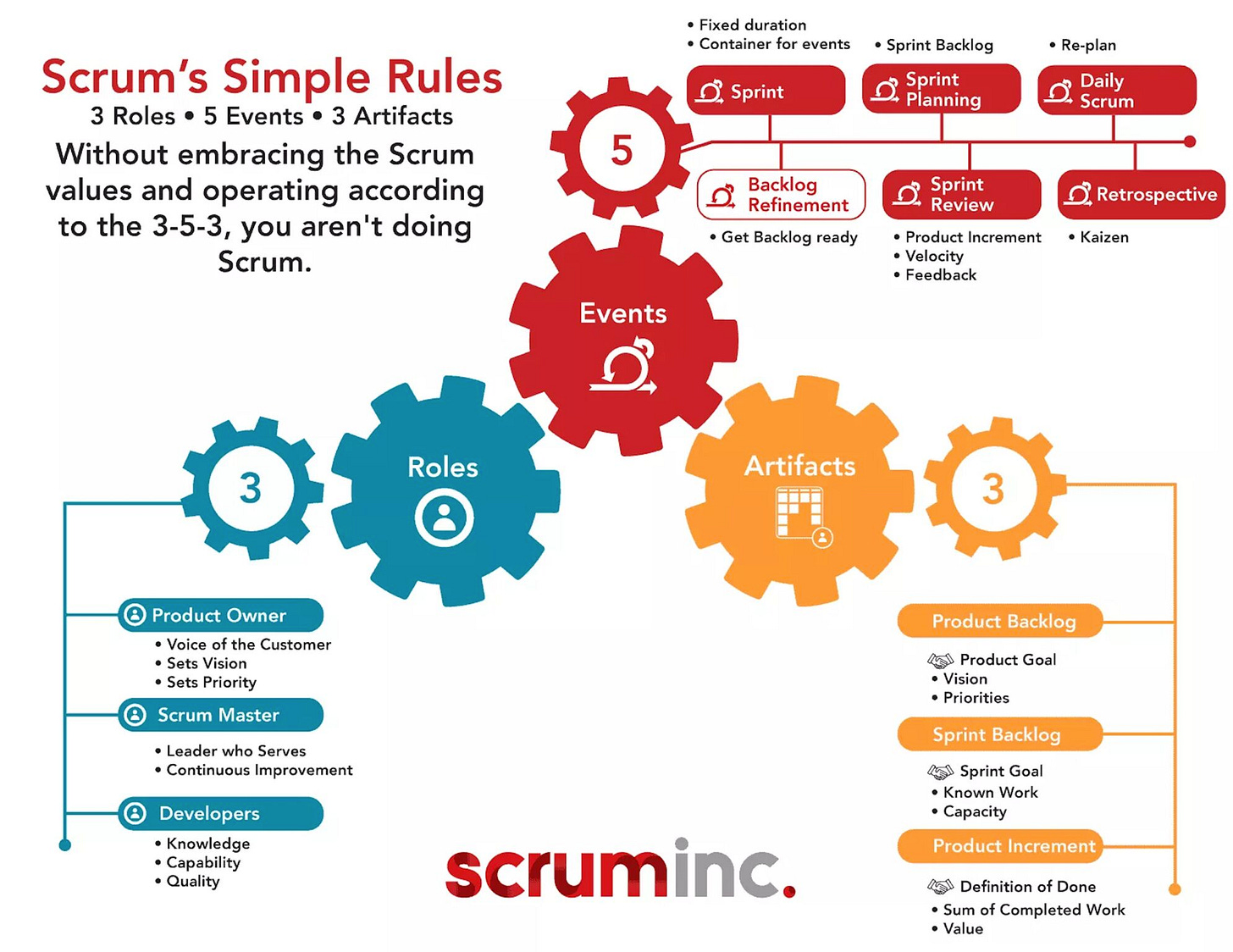Reading time: 4 minutes
Mechanical Scrum is a plague.
Too many teams suffer from it.
They are either getting less benefit from using Scrum than they could, or even worse, they're actually hurt by using it.
When you think of "Scrum at its most basic level" what do you think of?
3 roles and 5 events? If this was your answer, then you're probably on a team doing Mechanical Scrum too.
Unfortunately, this is the way that we’re typically taught about Scrum. I just saw this image:
It boils a highly nuanced method for working down to a series of checkboxes. This mindset virtually guarantees that you’re just going to be ticking boxes about everything. There is no reason behind your work methods, just a series of meetings you’re forced to attend.
Change the way you think of it - those 3 roles and 5 events are just a scaffolding built to let you more easily use Scrum.
In my opinion, "Scrum at its most basic level" is about using Transparency, Inspection, and Adaptation at every turn to constantly find better ways of working.
In addition, the Scrum Events are secondary to the purpose of the Scrum Events.
Sprints are where ideas are turned to value. This means whatever length our work period, we start with ideas and end with value. The team is not just being fed tasks to complete. Instead they are posed questions, or presented with problems in need of solutions.
The purpose of Sprint Planning is to set a Goal, understand what work needs to be done to reach it, and create a plan to deliver on that Goal. The team collectively creates a plan for what they’ll do, why they’re doing it, and how it will be done. This is not just the PO telling the team what they will do.
The purpose of the Daily Scrum is to inspect progress toward the Sprint Goal and adjust the upcoming planned work as necessary. The team maintains its focus on the Goal and meets daily to discuss how they need to adjust their plan in order to meet it. It’s not a time for reporting the status of the work being done.
The purpose of the Sprint Review is to inspect the outcome of the Sprint and determine future adaptations. This requires that everyone whose input is important to make decisions about the future of the product comes together for a working session.
The purpose of the Sprint Retrospective is to plan ways to improve quality and effectiveness.
Here’s how I think we should be thinking of Scrum first, before we think about roles or events.
Scrum is a framework for product development teams in which we iteratively turn ideas into value.
We do this by setting achievable goals, determining what work needs to be done to achieve them, and making short-term plans to reach those goals.
We check on our progress everyday as we learn more and adjust our plan when needed.
Periodically, we meet with all interested parties to discuss our progress and adapt our larger future product plans.
We also regularly find ways to be more effective and raise the quality level of our product.
All of these actions are facilitated by always being fully transparent about our work, constantly inspecting our product and our work methods, and adapting the moment we see a need for change.
Apply this mindset, and Scrum will come alive for you and your team.
When you as a Scrum Master teach your teammates about Scrum, teach the WHY first.
When you facilitate Scrum Events, remind everyone of the purpose of the event, and ask them to look for ways to use empiricism. Do this at the beginning of every event to put people in the right mindset.
Identify events that are not meeting their purpose, and point them out to the team (transparency). Use your retrospective or another workshop to put those events under a microscope with your team (inspection) to figure out what went wrong. Then conduct experiments together to get the events back on track (adaptation) so they will help the team.
Subscribe to my newsletter to get it sent directly to your email inbox every week, and connect with me on LinkedIn at https://linkedin.com/in/scrumify.
Whenever you're ready, here's how I can help:
If you’re trying to Get Your First Scrum Master Job, check out my video course that walks you through the 15 things you’re going to need to do.
I've created a framework for Personal Agility called Scrumify. Click this link to read it for free.
Join the Scrumify Community! I just launched a Discord channel for Agilists and aspiring Agilists to chat in real time, make connections, and help each other - and it’s free! Click here.


This is exactly the same as I think about how scrum (and agile more generally) is taught, and how people early in their scrum journey end up implementing it. Thanks for putting it down in one place :)
Many thanks Jeremy! This is really helpful. I just love the way you've put your content.